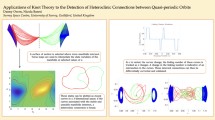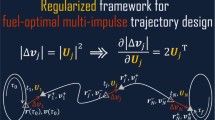Abstract
This paper is concerned with the problem of the optimal coplanaraeroassisted orbital transfer of a spacecraft from a high Earth orbitto a low Earth orbit. It is assumed that the initial and final orbits arecircular and that the gravitational field is central and is governed by theinverse square law. The whole trajectory is assumed to consist of twoimpulsive velocity changes at the begin and end of one interior atmosphericsubarc, where the vehicle is controlled via the lift coefficient.
The problem is reduced to the atmospheric part of the trajectory, thusarriving at an optimal control problem with free final time and liftcoefficient as the only (bounded) control variable. For this problem,the necessary conditions of optimal control theory are derived. Applyingmultiple shooting techniques, two trajectories with different controlstructures are computed. The first trajectory is characterized by a liftcoefficient at its minimum value during the whole atmospheric pass. For thesecond trajectory, an optimal control history with a boundary subarcfollowed by a free subarc is chosen. It turns out, that this secondtrajectory satisfies the minimum principle, whereas the first one fails tosatisfy this necessary condition; nevertheless, the characteristicvelocities of the two trajectories differ only in the sixth significantdigit.
In the second part of the paper, the assumption of impulsive velocitychanges is dropped. Instead, a more realistic modeling with twofinite-thrust subarcs in the nonatmospheric part of the trajectory isconsidered. The resulting optimal control problem now describes the wholemaneuver including the nonatmospheric parts. It contains as controlvariables the thrust, thrust angle, and lift coefficient. Further,the mass of the vehicle is treated as an additional state variable. For thisoptimal control problem, numerical solutions are presented. They are comparedwith the solutions of the impulsive model.
Similar content being viewed by others
References
London, H. S., Change of Satellite Orbit Plane by Aerodynamic Maneuvering, Journal of the Aerospace Sciences, Vol. 29, pp. 323–332, 1962.
Walberg, G. D., A Survey of Aeroassisted Orbit Transfer, Journal of Spacecraft and Rockets, Vol. 22, pp. 3–17, 1985.
Mease, K. D., Optimization of Aeroassisted Orbital Transfer: Current Status, Journal of the Astronautical Sciences, Vol. 36, pp. 7–33, 1988.
Naidu, D. S., Aeroassisted Orbital Transfers: Guidance and Control Strategies, Lecture Notes in Control and Information Sciences, Springer, New York, NY, Vol. 188, 1994.
Miele, A., Recent Advances in the Optimization and Guidance of Aeroassisted Orbital Transfer, The 1st John V. Breakwell Memorial Lecture, Acta Astronautica, Vol. 38, pp. 747–768, 1996.
Mease, K. D., and Vinh, N. X., Minimum-Fuel Aeroassisted Coplanar Orbit Transfer Using Lift Modulations, Journal of Guidance, Control, and Dynamics, Vol. 8, pp. 134–141, 1985.
Miele, A., and Venkataraman, P., Optimal Trajectories for Aeroassisted Orbital Transfer, Acta Astronautica, Vol. 11, pp. 423–433, 1984.
Miele, A., Wang, T., and Deaton, A. W., Properties of the Optimal Trajectories for Coplanar, Aeroassisted Orbital Transfer, Journal of Optimization Theory and Applications, Vol. 69, pp. 1–30, 1991.
Miele, A., and Wang, T., Gamma Guidance of Trajectories for Coplanar, Aeroassisted Orbital Transfer, Journal of Guidance, Control, and Dynamics, Vol. 15, pp. 255–262, 1992.
Baumann, H., Complete Trajectories of an Aeroassisted Orbital Transfer, Optimal Control in Transatmospheric Flight, Workshop Greifswald, Greifswald, Germany, 1999 (to appear).
Oberle, H. J., and Taubert, K., Existence and Multiple Solutions of the Minimum-Fuel Orbit Transfer Problem, Journal of Optimization Theory and Applications, Vol. 95, pp. 243–262, 1997.
Bryson, A. E., and Ho, Y. C., Applied Optimal Control, Ginn and Company, Waltham, Massachusetts, 1969.
Bulirsch, R., The Multiple Shooting Method for the Numerical Solution of Nonlinear Boundary-Value Problems and of Optimal Control Problems, Report of the Carl–Cranz–Gesellschaft e.V., Oberpfaffenhofen, Germany, 1971 (in German).
Stoer, J., and Bulirsch, R., Introduction to Numerical Analysis, 2nd Edition, Corrected 3rd Printing, Texts in Applied Mathematics, Springer, New York, NY, Vol. 12, 1996.
Oberle, H. J., and Grimm, W., BNDSCO—A Program for the Numerical Solution of Optimal Control Problems, Report 515, Institut for Flight Systems Dynamics, German Aerospace Research Establishment (DLR), Oberpfaffenhofen, Germany, 1989.
Baumann, H., Numerical Computation of Optimal Aeroassisted Orbital Transfers, Diploma Thesis, University of Hamburg, 1998 (in German).
Chudej, K., Generalized Necessary Conditions for State-Constrained Optimal Control Problems with Piecewise Model Functions, Zeitschrift für Angewandte Mathematik und Mechanik, Vol. 75, pp. 587–588, 1995 (in German).
Author information
Authors and Affiliations
Rights and permissions
About this article
Cite this article
Baumann, H., Oberle, H.J. Numerical Computation of Optimal Trajectories for Coplanar, Aeroassisted Orbital Transfer. Journal of Optimization Theory and Applications 107, 457–479 (2000). https://doi.org/10.1023/A:1026454013374
Issue Date:
DOI: https://doi.org/10.1023/A:1026454013374




